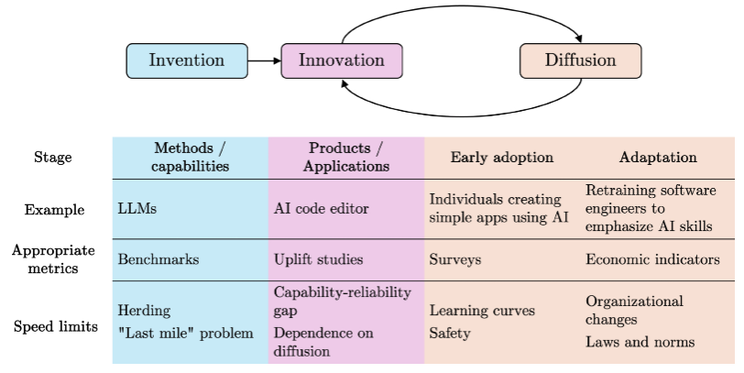AI Deployment: Lessons from History on Technology Adoption
• 4 min read### The PhD-level AI myth
*The next model update [o1] performs similarly to PhD students on challenging benchmark tasks in physics, chemistry, and biology*, according to OpenAI ([1]). We hear more and more that we will soon have AI models with PhD-level intelligence. While there is certainly a lot of hype and marketing in these claims, we would welcome such models!
That's all interesting. But when did you need PhD-level intelligence to automate your work? There are very few jobs that require PhD-level intelligence, yet AI adoption in enterprises remains surprisingly slow. Currently, we see no improved economic indicators, which would be the measurable impact of AI adoption at scale.
Why is that? Why do we see so few value-creating use cases despite remarkable advances in AI capabilities?
### Learning from history
To better understand the reason for slow adoption, we can look at history, as did Arvind Narayanan and Sayash Kapoor from Princeton University, who write: *Like other general-purpose technologies, the impact of AI is materialized not when methods and capabilities improve, but when those improvements are translated into applications and are diffused through productive sectors of the economy. There are speed limits at each stage.* ([2])

*Technology Diffusion. From ([2])*
The speed of Inventions (LLMs, agents) is currently not the limiting factor. The limiting factor is the speed of Innovation and Diffusion.
### The real barriers to adoption
Diffusion in safety-critical areas is slow - this is expected. But in other areas, the limitations come from the speed of human, organizational, and institutional change. Anyone pushing for AI adoption in an established company will quickly realize this: established companies have entrenched processes. And these processes are not necessarily adapted to the age of AI.
Consider a mid-sized financial services company implementing AI for customer support. The technical integration might take weeks, but updating compliance procedures, retraining staff, and redesigning workflows can take months or years. The AI capabilities are ready, but the organization isn't.
### The electricity parallel
This pattern was already observed with the advent of electricity in the early 20th Century, which took decades to boost factory efficiency. It had to be realized that simply replacing the steam engine with electric power in the middle of the factory was not the right approach. Crucially, the breakthrough came when innovators understood that electricity could be used fundamentally differently than steam - it could be distributed throughout the workspace rather than centralized. This insight didn't emerge instantly but through collective experimentation and learning across industries.
Electricity allowed energy to be brought to each workplace. This required a complete redesign of factory layouts and how work was organized and controlled. This transformation demanded massive changes to physical infrastructure and employee workflows - what we now call change management. And this comprehensive shift in both understanding and implementation took nearly 40 years.
Therefore, change is difficult. And often slow.
### What does this all mean for you?
What's particularly interesting is the widening "adoption gap" between organizations. While tech giants and AI-first startups implement AI solutions in weeks, traditional enterprises often take years for a similar implementation because of legacy processes and lack of agility. This gap represents both risk and opportunity in today's market.
**As an individual**, be an early adopter! This will make you significantly more efficient than the average person. You'll maintain this advantage as long as AI adoption remains weak in your field.
**As an entrepreneur**, take advantage of building an AI-first company. You'll outpace traditional companies for a few years, until they adapt. The winners won't necessarily be those with the most advanced AI, but those who integrate it most effectively into their operations.
**As an established company**, keep an eye on technological progress and adjust your processes to make them compatible in the AI age. Start small, focus on quick wins, and build institutional knowledge about implementation - not just capability.
The race isn't about having the latest AI model; it's about deploying it effectively within your organization's unique context. That's where the real competitive advantage lies.
[1]: https://openai.com/index/introducing-openai-o1-preview/
[2]: https://knightcolumbia.org/content/ai-as-normal-technology
---
I partner with organizations, particularly in private markets, to redesign workflows and accelerate the transition to effective AI adoption. Connect if your firm is navigating this change.